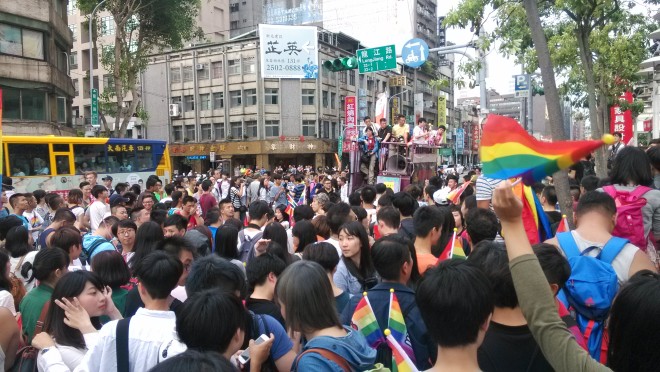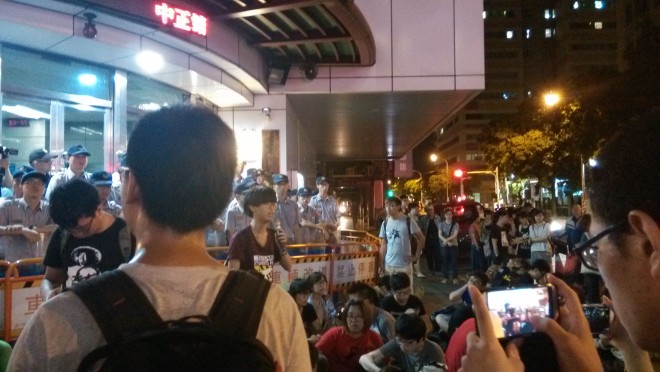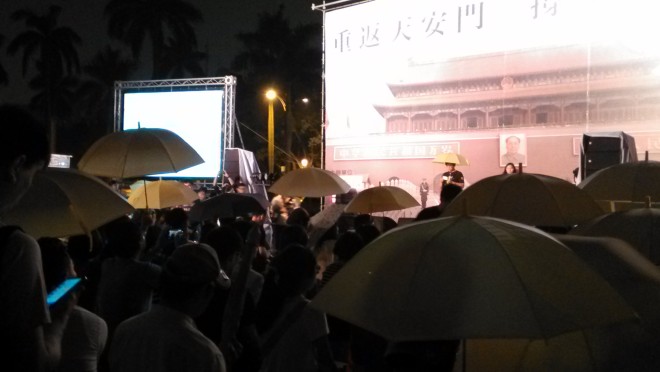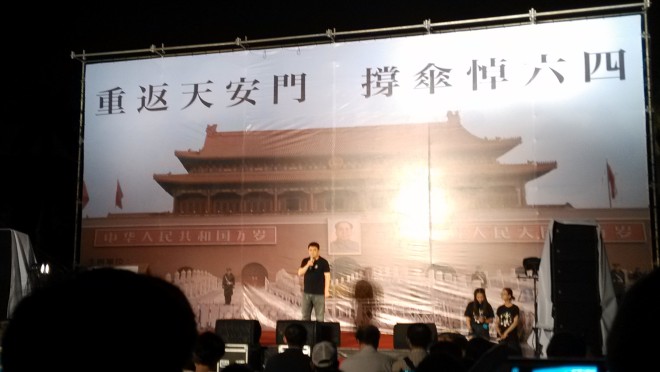Upwards of a thousand demonstrators gathered yesterday afternoon in front of KMT headquarters to demonstrate in support of gay marriage, before proceeding to DPP headquarters, and ending with a rally in front of the Legislative Yuan. Though an exact count of participants is unknown, CNA reports greater than a thousand demonstrators. Very probably the actual number was several times that. The main organizer of the event was the Taiwan Alliance to Promote Civil Partnership Rights (TAPCPR).
Groups present included the Social Democratic Party, the Green Party, and Taiwan March. That the Social Democratic Party and Green Party contingents marched together, we can point to as a further sign of closer ties between the Social Democratic Party and Green Party as of late. Social Democratic Party politicians Jennifer Lu and Miao Poya were both present. Where the Social Democratic Party has foregrounded sexual and gender inequality as a major issue which it seeks to address through its party platform, it has put forth a number of female political candidates including openly gay politicians such as Lu and Miao. As such, it is not surprising that the Social Democratic Party was out in force, distributing colored rainbow flags with its party logo among demonstrators.
Apart from political parties, volunteers collecting money for victims of the Color Play Asia fire in which over 500 were left burned after a sudden blaze during a party event at Formosa Fun Coast Water Park last month were also a constant presence. Taiwan March’s presence was largely aimed at collecting signatures for referendum reform.
Speeches at the protest as organized under the auspices of the TAPCPR pointed towards dissatisfaction with both major political parties in Taiwan with regards to gay marriage, although we can note some contradictory attitudes on the part of organizers. After demanding that the KMT come out to formally acknowledge their demands and offer a response, but no KMT representative venturing out of party headquarters, demonstrators pelted KMT headquarters with colored water balloons in acknowledgement of general hostility by the part of the KMT towards the legalization of gay marriage.
However, this action was immediately followed by a speech by KMT youth league leader Lin Chia-Hsing. Lin Chia-Hsing, although a devoted member of the KMT, has gained something of a reputation within the Taiwanese activist community for his frequent appearances at civil society events in an attempt to rehabilitate the KMT’s image and the hostility of the young activists of the Sunflower generation towards the KMT.
Though it is recognized that Lin is of the same generation as the Sunflowers, can speak the same language as them, and is quite concerned with issues of labor, gay rights, and other social issues that Taiwanese civil society takes up, Lin’s quixotic quest to make the KMT appealing to Taiwanese young people is forever forestalled by the limitations placed upon him by his undying loyalty to the KMT and the ideology it professes. Lin’s speech was bizarre, beginning by asking whether any Chinese were present (likely there were, but none in Lin’s immediate vicinity, which seemed to catch him off guard) and crediting his awareness of LGBTQ issues to mainland Chinese individuals. Lin also avoided discussion of that the KMT has generally been opposed to gay marriage, largely effacing the issue, although pro-KMT media has attempted to pretend that Lin had taken a supportive stance towards the protest. As for the reactions of demonstrators, I recall hearing some comments from near where I was standing that Lin’s speech had been “confusing nonsense.”
After a long march through the hot afternoon past the Sogo department store by Zhongxiao Fuxing, demonstrators next presented their demands to the DPP in front of DPP headquarters. Organizers emphasized in speeches that while the DPP had not been hostile towards gay marriage in the manner of the KMT and had been more supportive, there were those DPP legislators who are opposed, and that it is such that the DPP was to also come under the scrutiny of Taiwan’s LGBTQ community.
In contrast to the KMT, the DPP did send a representative out to respond to protestors, whose subsequent speech emphasized the support of current DPP party chairman Tsai Ing-Wen and former DPP party chairman Su Tseng-Chang for same-sex marriage. However, after applauding these sentiments from the DPP just a few moments earlier, organizers asked the crowd whether they were satisfied with either the response of the KMT or the DPP. The cry was: “No!” But rather than pelt DPP headquarters with water balloons, as organizers phrased it, in acknowledgement of the differences which did exist between the KMT and DPP, demonstrators would instead “quietly withdraw.”
The final destination on the itinerary of protestors was the Legislative Yuan, where protestors gathered on Jinan Road for the conclusion of the demonstration. Apart from speeches that capped off the day’s actions, organizers lit candles in the same of the words “平權“ (“Equal Rights”) and “平安” (“Peace”). The last speakers were two veterans of the gay rights struggle in Taiwan, who had been active for over thirty years, closing the event with a sharing of experiences between an older generation and largely younger participants.
The emphasis of organizers was on dissatisfaction with both parties, rather than any attempt to be bipartisan; nevertheless, there was the claim made during speeches that the issue of gay marriage was one which transcended pan-Blue/pan-Green political divisions in Taiwan. Yet as was noted by many attendees, police presence was significantly higher outside KMT party headquarters than outside DPP headquarters, with two buses full of riot police on standby nearby. This would be, of course, a case of the police acting on behalf of the KMT.
Indeed, where the actions of Taiwanese police largely in service of the KMT government is concerned, as protestors gathered outside the Legislative Yuan, barbed wire set up to keep protestors outside of the Ministry of Education for recent protests earlier this month against textbook revisions with a pro-China historical slant were still visible nearby. And this was something on the mind of attendees too, a large rainbow-colored paper airplane carried by protestors harkening to the symbol of recent protests against textbook revision of the paper airplanes which were thrown into the Ministry of Education’s courtyard during a large-scale protest action earlier this month. This only points at how gay marriage is bound up with a whole host of political issues roughly stemming from the KMT and its ability to sanction what counts as legitimate public morality for Taiwanese, whether in regards to education or sexuality—though, of course, such issues are not wholly reducible to the role of the KMT either.
However, what now going forward for the Taiwanese LGBTQ movement? That may be the question facing the LGBTQ movement worldwide, especially after the legalization of gay marriage in the United States last month and that in its wake the global cultural influence of the US has led the decision-making bodies of many a nation to discuss the possibility of legalizing gay marriage for the first time. Certainly, this will have effect in Taiwan. We may note that, for example, Taipei mayor Ko Wen-Je formerly claimed that he would consider supporting same-sex marriage once half the states in the United States had legalize it—of course, now it is that all states in the United States have legalized same-sex marriage.
And certainly divides exist within the LGBTQ community, with some viewing marriage as an institution of oppression that one should not seek to find inclusion in. To my awareness, this debate was only acknowledged once by organizers near the end of the protest, with the claim that before one could speak of going beyond the institution of marriage, equality would have to be achieved within the institution of marriage. But is now a decisive time for Taiwan’s marriage equality movement? We shall see in coming days and months.
Author: Brian Hioe
Photo Credit: Brian Hioe
Biography: Brian Hioe (丘琦欣) is an M.A. student at Columbia University, a freelance writer on politics and social activism, and an occasional translator. He is formerly a resident of Taipei, Taiwan.































